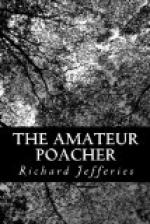At the shank end a stout string is attached in the middle of its length. Then the wire is placed against the rod, lying flat upon it for about six inches. The strings are now wound round tightly in opposite directions, binding it to the stick, so that at the top the ends cross and are in position to tie in the slight notch cut for the purpose. A loop that will allow four fingers to enter together is about large enough, though of course it must be varied according to the size of the jack in view. Heavy jacks are not often wired, and scarcely ever in brooks.
For jack the shape of the loop should be circular; for trout it should be oval, and considerably larger in proportion to the apparent bulk of the fish. Jack are straight-grown and do not thicken much in the middle; with trout it is different. The noose should be about six inches from the top of the rod. Orion said he would go twenty yards farther up; I went direct from the centre of the withy-bed to the stream.
The bank rose a little above the level of the withy-bed; it was a broad mound full of ash stoles and willow—the sort that is grown for poles. At that spot the vines of wild hops had killed all the underwood, leaving open spaces between the stoles; the vines were matted so thickly that they hid the ground. This was too exposed a place, so I went back and farther up till I could just hear Orion rustling through the hemlocks. Here the dead grass and some elder bushes afforded shelter, and the water could be approached unseen.
It was about six or eight inches deep; the opposite shore was bordered for several yards out with flags and rushes. The cattle nibbled their tender tops off, as far as they could reach; farther out they were pushing up straight and pointed. The rib and groove of the flag so closely resemble those of the ancient bayonet that it might be supposed the weapon was modelled from the plant. Indoors among the lumber there was a rusty old bayonet that immediately called forth the comparison: the modern make seem more triangular.
The rushes grew nearer the shore of the meadow—the old ones yellow, the young green: in places this fringe of rush and sedge and flag must have been five or six yards wide, and it extended as far as could be seen up the brook. No doubt the cattle trod in the edge of the firm ground by degrees every year to get at the water, and thus widened the marsh. It was easy to understand now why all the water-fowl, teal and duck, moorhen and snipe, seemed in winter to make in this direction.
The ducks especially exercised all our ingenuity and quite exhausted our patience in the effort to get near them in winter. In the large water-meadows a small flock sometimes remained all day: it was possible to approach near enough by stalking behind the hedges to see the colour of the mallards; but they were always out of gunshot. This place must be full of teal then; as for moorhens, there were signs of them everywhere, and several feeding in the grass. The thought of the sport to be got here when the frosty days came was enough to make one wild.




